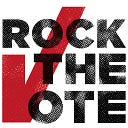How Rock The Vote is Commemorating the Anniversary of the Voting Rights Act
With August right around the corner, Rock the Vote is gearing up for the 55th anniversary of the Voting Rights Act. Signed into law by President Lyndon B. Johnson on August 6, 1965, the VRA aimed to protect the voting rights of Black citizens. While it outlawed the use of discriminatory voting practices, each election is still an uphill battle in fighting de facto voter suppression towards BIPOC, young people, and people living with disabilities.
Parts of the VRA — Section 4b’s coverage formula and Section 5’s preclearance clause — were found to be unconstitutional in 2013, thereby weakening several of the key provisions that once protected voters living in states with a history of racially motivated voter suppression. Here’s how we got here:
HISTORY OF THE VRA
So why was the VRA originally implemented, and why do we still need it today? First , the Constitution of the United States does not explicitly grant the right to vote, but rather addresses these issues through various amendments. The 15th, 19th, and 26th Amendments all worked tenaciously to prevent discrimination of citizens’ right to vote based on prior servitude, race, belief, color, ethnicity, sex, and age of those who are at least 18 years old. Despite these protections, state and local governments have found ways to disenfranchise certain groups.
Discriminatory practices, such as poll taxes, literacy tests, Jim Crow laws, intimidation and outright violence were all once weaponized in order to prevent Black Americans from voting. This is why something stronger, like the VRA, was needed to prevent states from passing discriminatory election laws. This way, if voting rights are extended to one group of people, they cannot be denied to other groups of people.
Since its introduction, Congress had renewed and amended the VRA five times, all with little opposition. In 2006, President George W. Bush signed the Act’s second 25-year extension. The VRA went on to include protections for voters with language barriers and disabilities.
However, it was not long before a 2013 lawsuit struck down some of the most crucial inclusions in the Act. Before we get into Shelby County v. Holder and the damage it did to voter equality, let’s take a look at the way the VRA attempted to hold state’s to a high standard of voter protection.
HOLDING STATES ACCOUNTABLE
As mentioned, states had found ways to work around federal anti-discrimination laws in the past, and the VRA wanted to ensure that this could not happen so easily again. Section IV (4b) of the Act established a formula to determine which state and local governments demonstrated a history of voting rights violations. Additionally, Section V (5) established a preclearance requirement in which the jurisdictions identified by the formula in Section IV (4b) must obtain “preclearance” from the federal government before making any changes to their voting laws and policies.
Eventually, states like Alabama, Alaska, Arizona, Georgia, Louisiana, Mississippi, South Carolina, Texas, and Virginia, as well as counties in California, Florida, Michigan, North Carolina, South Dakota, and New York, were obligated to submit plans to either the Justice Department or a Federal Court before making any changes to their election laws whatever in order to prevent voter suppression, especially on the basis of race. This aspect of accountability is one of the reasons that the VRA was so effective. In fact, it’s widely considered to be the most effective piece of civil rights legislation in US history.
OPPOSITION TO THE VRA TODAY
In 2013, Shelby County, Alabama challenged the VRA’s preclearance clause in a lawsuit against the Justice Department. In a 5–4 decision, the Supreme Court held that the Section IV (4b) formula used to determine which states and localities were subject to preclearance was outdated and was therefore unconstitutional. Because the court did not find the preclearance clause itself unconstitutional, just the formula for determining which states are subject to it, Congress could update the formula at any time. But now it is seven years later, and Congress has not updated the formula.
Without this critical formula, the preclearance requirement in Section V (5) is unenforceable. This means that regions with a history of discrimination no longer have federal oversight before changing their voting processes. This means that regions with a history of discrimination no longer have any kind of federal oversight before changing their voting processes — essentially giving them free rein to implement voter suppression tactics across the country.
Since then, states and localities — both those previously covered by the VRA formula and others that had not been covered — have been able to pass discriminatory laws such as voter ID and proof of residency requirements, shut down polling sites, voter list purging, and amend pre-existing laws without oversight. Today, we need to call on Congress and put pressure on our Representatives and Senators to not only restore the VRA but to expand it to include new voter suppression tactics.
WHAT CAN WE DO?
- With Election Day only a few months away, it’s never been more important to put pressure on our elected officials to restore the VRA and expand it to give us a fighting chance against these voter suppression tactics.
- It’s also incredibly important to encourage large voter turnout to overcome these voter suppression tactics we see all over the country. Even with everything else going on, we must continue everything we can to protect the right to vote, particularly for communities who are being actively suppressed and denied their right to vote around the country.
- Rock the Vote has resources at RockTheVote.org to help people and their communities get involved in the fight for voting rights and stay informed on where/how to vote in their state.
